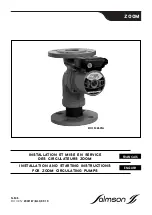
OPERATION
Priming with an In-line Check Valve
6
4. Wire the connections.
• Connect the power lines to the pressure switch terminals marked L1 and L2.
• Very long leads will require a larger cable.
• For added safety, the pump and motor should be grounded to the well casing, if metal, or the
ground in the distribution panel.
5. For driven wells, water levels may be too low to pump at times. Have an electrician replace the pres
-
sure switch with a low pressure cut-off switch to prevent pump damage.
OPERATION
Priming with an In-line Check Valve
1. Open the discharge valve on the service line and nearby tap to monitor the water flow.
2. Remove the priming plug with a wrench.
3. Pour approximately 1 quart (1 liter) of clean water for every 3 ft (1 m) of suction line through the
priming plug opening until water flows out of the priming hole.
4. Reinstall the priming plug. Hand tighten.
5. Start the pump.
• If a tap is visible, you may see a short discharge of water for about 5 to 10 seconds.
6. Run the pump for 2 minutes. Shut off.
7. Repeat steps 2 - 6 for every 5 ft (1.5 m) of suction line until the water is pumped continuously.
• Priming will be repeated about 2 - 6 times.
• If the pump does not draw water within 8 tries, shut it off and check the suction line for leaks.
8. Firmly tighten the priming plug with a wrench.
Priming with a Foot Valve
1. Open the discharge valve on the service line and nearby tap to monitor the water flow.
2. Remove the priming plug with a wrench.
3. Pour approximately 1 quart (1 liter) of clean water for every 3 ft (1 m) of suction line through the
priming plug opening until water flows out of the priming hole.
NOTE:
If the suction line does not fill, follow the directions for an in-line check valve.
4. Reinstall the priming plug. Hand tighten.
5. Start the pump.
• If the pump is primed correctly, it should start pumping water immediately.
• If water does not continuously pump within 2 minutes, repeat steps 2 - 5.
• If a second priming does not give a continuous flow, stop the pump and check the suction line
for leaks.
6. Firmly tighten the priming plug with a wrench.
Risk of damage to pump or other equipment.
•
Pumping sand or other abrasives can damage the pump and void the warranty.
•
If pump is run dry, it may damage pump and void the warranty.
Summary of Contents for 602240
Page 34: ...34 NOTAS...
Page 35: ...35 NOTAS...







































